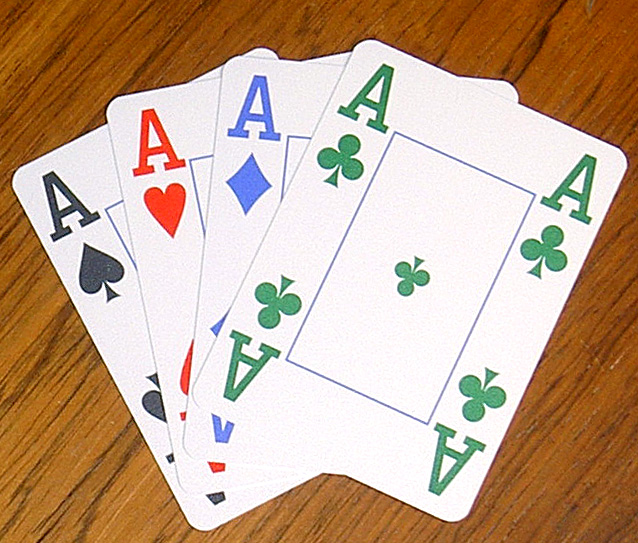Diamonds (card Suit) on:
[Wikipedia]
[Google]
[Amazon]

 Diamonds
Diamonds  is one of the four suits of playing cards in the standard French deck. It is the only French suit to not have been adapted from the German deck, taking the place of the suit of Bells
is one of the four suits of playing cards in the standard French deck. It is the only French suit to not have been adapted from the German deck, taking the place of the suit of Bells  .
The original
.
The original
File:01 of diamonds A.svg, Ace
File:02 of diamonds.svg, 2
File:03 of diamonds.svg, 3
File:04 of diamonds.svg, 4
File:05 of diamonds.svg, 5
File:06 of diamonds.svg, 6
File:07 of diamonds.svg, 7
File:08 of diamonds.svg, 8
File:09 of diamonds.svg, 9
File:10 of diamonds - David Bellot.svg, 10
File:Jack of diamonds fr.svg, Jack
File:Queen of diamonds fr.svg, Queen
File:King of diamonds fr.svg, King

 in English and German packs
* yellow
in English and German packs
* yellow  in American decks and German Skat tournament packs''Gallery 3 - Sizes, Shapes and Colours''
in American decks and German Skat tournament packs''Gallery 3 - Sizes, Shapes and Colours''
at a_pollett.tripod.com. Retrieved 4 Aug 2020. or * blue in English and American Poker decks,
in English and American Poker decks,
at pokernews.com. Retrieved 4 August 2020. French and Swiss four-colour packs.
 Diamonds
Diamonds French
French (french: français(e), link=no) may refer to:
* Something of, from, or related to France
** French language, which originated in France, and its various dialects and accents
** French people, a nation and ethnic group identified with Franc ...
name of the suit is Carreau; in German it is known as Karo.
In older German-language accounts of card games, Diamonds are frequently referred to as ''Eckstein'' ("cornerstone"). In Switzerland
). Swiss law does not designate a ''capital'' as such, but the federal parliament and government are installed in Bern, while other federal institutions, such as the federal courts, are in other cities (Bellinzona, Lausanne, Luzern, Neuchâtel ...
, the suit is still called ''Egge'' (=''Ecke'' i.e. "corner") today. The term "Karo" went into the German language in the 18th century from the French ''carreau'', which goes back to the Latin word, ''quadrum'', meaning "square" or "rectangle".
Characteristics
The diamond typically has a lozenge shape, aparallelogram
In Euclidean geometry, a parallelogram is a simple (non- self-intersecting) quadrilateral with two pairs of parallel sides. The opposite or facing sides of a parallelogram are of equal length and the opposite angles of a parallelogram are of equa ...
with four equal sides, placed on one of its points. The sides are sometimes slightly rounded and the four vertices placed in a square, making the sign look like an astroid.
Normally diamonds are red in colour. They can however be depicted in blue, which is the case for example in bridge (where it is one of the two minor suits along with Clubs). In the official Skat tournament deck, diamonds are yellow or orange, assuming the color of their German-deck equivalent, which are usually golden.
The following gallery shows the diamonds from a 52-card deck
The standard 52-card deck of French-suited playing cards is the most common pack of playing cards used today. In English-speaking countries it is the only traditional pack used for playing cards; in many countries of the world, however, it is used ...
of French playing cards. Not shown is the Knight of Diamonds used in the tarot card games:
Four-colour packs

Four-colour pack
A four-color deck (US) or four-colour pack (UK) is a deck of playing cards identical to the standard French deck except for the color of the suits. In a typical English four-color deck, hearts are red and spades are black as usual, but clubs ...
s are sometimes used in tournaments or online. In such packs Diamonds may be:
* orange  in American decks and German Skat tournament packs''Gallery 3 - Sizes, Shapes and Colours''
in American decks and German Skat tournament packs''Gallery 3 - Sizes, Shapes and Colours''at a_pollett.tripod.com. Retrieved 4 Aug 2020. or * blue
 in English and American Poker decks,
in English and American Poker decks,at pokernews.com. Retrieved 4 August 2020. French and Swiss four-colour packs.
Coding
The symbol ♦ is already in theCP437
Code page 437 (CCSID 437) is the character set of the original IBM PC (personal computer). It is also known as CP437, OEM-US, OEM 437, PC-8, or DOS Latin US. The set includes all printable ASCII characters as well as some accented letters (diacr ...
and therefore also part of Windows WGL4
Windows Glyph List 4, or more commonly WGL4 for short, also known as the ''Pan-European character set'', is a character repertoire on Microsoft operating systems comprising 657 Unicode characters, two of them private use. Its purpose is to provide ...
. In Unicode a black ♦ and a white ♢ diamond have been defined:
References
Literature
*External links
{{Playing card Card suits da:Ruder